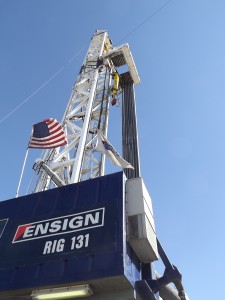Dropping Oil Prices = Changing Landscape for E&Ps, Midstream, OilService Companies
At last week’s 2014 Energy Symposium hosted by Wells Fargo Securities at the Waldorf Astoria, the sentiment expressed by the energy companies was far different from what had been coming out of similar meetings before a global oil price slide which began in the summer of 2014.
Midstream companies presenting at the New York City conference included many of the best-known names in the sector: Enterprise Products Partners LP (ticker: EPD), Plains All American Pipeline (ticker: PAA), Enbridge Energy Partners (ticker: EEP), Access Midstream Partners LP (ticker: ACMP), EnLink Midstream Partners (ticker: ENLK), TeeKay LNG Partners (ticker: TGP), MarkWest Energy Partners (ticker: MWE), Kinder Morgan (ticker: KMI) and many others.
 On the E&P side, presenters included Carrizo Oil & Gas (ticker: CRZO), Goodrich Petroleum (ticker: GDP), ConocoPhillips (ticker: COP), Bill Barrett Corporation (ticker: BBG), Penn Virginia Corporation (ticker: PVA), PDC Energy (ticker: PDCE), Eclipse Resources (ticker: ECR), Bonanza Creek Energy (ticker: BCEI) and Ultra Petroleum (ticker: UPL).
On the E&P side, presenters included Carrizo Oil & Gas (ticker: CRZO), Goodrich Petroleum (ticker: GDP), ConocoPhillips (ticker: COP), Bill Barrett Corporation (ticker: BBG), Penn Virginia Corporation (ticker: PVA), PDC Energy (ticker: PDCE), Eclipse Resources (ticker: ECR), Bonanza Creek Energy (ticker: BCEI) and Ultra Petroleum (ticker: UPL).
OilService companies included U.S. Silica Holdings (ticker: SLCA), Nabors Industries (ticker: NBR) and Hornbeck Offshore Services (ticker: HOS).
EnerCom spoke with many of the presenting companies at the conference and noticed the following emerging trends and other observations from the meetings:
- Midstream providers have little-to-no exposure to commodity price or volumes due to the fee-based nature of their business. Many of their customers have take-or-pay contracts (or minimum volume contracts) which require payment regardless of the price of oil or the volume of oil processed. However, it stands to reason that if some producers enter into financial hardship, they will ask for relief from their contractual obligations. If relief is granted by the midstream providers, then their results do become subject to fluctuations in price and volume.
- Most producers are signaling significant cuts in capital expenditures and the resultant reduction in rig counts for 2015; however, many if not all are still forecasting production growth next year. If indeed one of the drivers of lower oil price is oversupply, and if production is still growing, at what point will the reduction in CapEx start to decrease production and return the market to equilibrium, thereby providing price support?
- Investors’ questions tended to focus on the ability of firms to weather the storm of lower crude prices, a reflection of the growing concern of risk management. Topics covered including the ability to manage current debt burden, the outlook for CapEx, hedge positions, distribution coverage, and redetermination of borrowing base.
- Many executives at the conference talked about the opportunity that low oil price brings when it comes to making acquisitions, particularly if you have built a strong balance sheet. The challenge will be reaching a valuation where a deal can be completed – the buyer will want to value based upon $60/bbl oil, where the seller may want to value at $90/bbl. An important factor is likely to be how stressed the seller is—i.e., how much do they need the cash more than the asset?
- Several questions focused on the difference between the current price movement and what the industry experienced in 2008-2009. People thought the biggest difference is that in 2008 the crisis was primarily financial (although one could argue that the current situation is partly driven by central bank policy). The other difference that was pointed out was that the current drop is less severe than before (at least as of last week); and natural gas prices have held up better compared with 2008-2009.
Important disclosures: The information provided herein is believed to be reliable; however, EnerCom, Inc. makes no representation or warranty as to its completeness or accuracy. EnerCom’s conclusions are based upon information gathered from sources deemed to be reliable. This note is not intended as an offer or solicitation for the purchase or sale of any security or financial instrument of any company mentioned in this note. This note was prepared for general circulation and does not provide investment recommendations specific to individual investors. All readers of the note must make their own investment decisions based upon their specific investment objectives and financial situation utilizing their own financial advisors as they deem necessary. Investors should consider a company’s entire financial and operational structure in making any investment decisions. Past performance of any company discussed in this note should not be taken as an indication or guarantee of future results. EnerCom is a multi-disciplined management consulting services firm that regularly intends to seek business, or currently may be undertaking business, with companies covered on Oil & Gas 360®, and thereby seeks to receive compensation from these companies for its services. In addition, EnerCom, or its principals or employees, may have an economic interest in any of these companies. As a result, readers of EnerCom’s Oil & Gas 360® should be aware that the firm may have a conflict of interest that could affect the objectivity of this note. The company or companies covered in this note did not review the note prior to publication. EnerCom, or its principals or employees, may have an economic interest in any of the companies covered in this report or on Oil & Gas 360®. As a result, readers of EnerCom’s reports or Oil & Gas 360® should be aware that the firm may have a conflict of interest that could affect the objectivity of this report.

